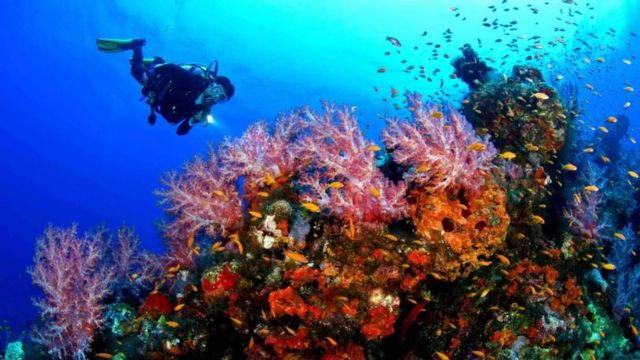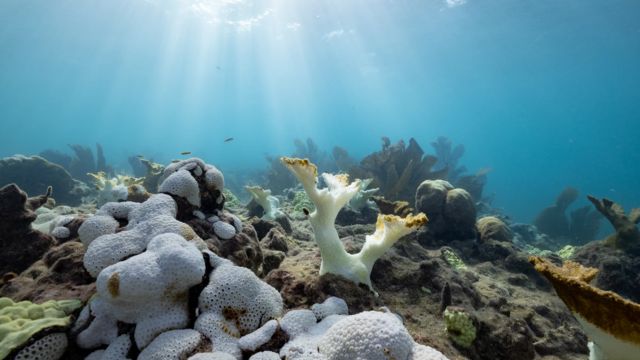With its waters undergoing major changes, Florida, a state known for its immaculate beaches and abundant marine life, is confronting an increasingly dire situation.
Overfishing, pollution, and rising sea levels are just a few of the environmental issues affecting Florida’s coastal habitats.
We will examine the concerning alterations taking place in Florida’s waters and talk about how conservation and sustainable practices are desperately needed to save this priceless natural resource.
What’s Happening Beneath Florida’s Waves?
Many regions of the world, including the US, are being severely impacted by climate change. In 2025, it is expected that not only will the oceans be hotter, but also some cities in the United States.
This is an issue since climate change is having a direct effect on the “rainforest of the ocean” beneath the waves.
Recent discoveries by scuba divers and snorkelers, however, indicate that there is a problem beneath Florida’s water that should concern everyone because it has serious repercussions for both humans and wildlife as well as the marine environment.
Because of excessively hot water, the coral reefs off the Florida coast have been undergoing the bleaching process.
Marine researchers are urging action since, following the catastrophic bleaching event in 2023, only a small portion of the coral reefs remain; if nothing is done, the land above will suffer in addition to the oceans due to the absence of corals.
Read Also: Florida Frights: The Top Haunted Locations You Shouldn’t Miss
Coral Bleaching Is Severe in Florida’s Oceans
Off the coast of Florida, corals have been under a lot of stress. The once colorful coral reefs have been bleached—the coral loses its algae and is completely white—due to the extremely warm water. The corals may die as a result of this harmful behavior.

Ninety percent of Florida’s coral has been gone in the past forty years. The NOAA created a plan to save the coral reefs as a result of this devastation.
The goal of that initiative was to restore the health of seven sick and dying reef locations by transplanting about 500,000 hand-raised coral colonies.
At $100 million, the idea was costly, but it also appeared to be sound. Unfortunately, with temperatures in some places over 100 degrees Fahrenheit, 2023 turned out to be the warmest year on record for the ocean waters in and around Southern Florida.
As a result, the young coral colonies not only bleached but also perished. Only 23% of the coral population remained alive as a result.
Even if the coral bleaching was less severe in 2024, it nevertheless happened. The likelihood that a coral species will not survive increases with the frequency of bleaching. Both people and wildlife are impacted by the corals’ decline.
Read Also: Oregon’s Whale Watching Capital: A Beach Town You Can’t Miss
What Impact Does Coral Bleaching Have on Humans and Wildlife?
From the perspective of natural disasters, the coral reefs off Florida serve as a buffer, absorbing some of the damage caused by hurricanes and tropical storms that hit coastal cities.

Coral reefs are on the verge of dying as their life cycle progresses and they start to bleach.
This implies that the underwater buffer that is so crucial for Florida will disappear if the coral dies. To fend off the enormous waves the storms bring, the Sunshine State will instead need to rely on seawalls and berms.
Economically, humans also suffer when corals perish. Without coral, the economy will suffer, especially for Floridians.
Read Also: Before You Swim in Palm Beach, Florida – Know This Hidden Danger
How Can Coral Bleaching Be Prevented Before It’s Too Late?
The reason for the most recent coral bleaching in Florida (and much of the world) is that an El Niño year has made the ocean temperatures considerably too warm to support life.
However, bleaching of coral is caused by different processes. This is why the amount of bleaching coral can be reduced if little actions are performed every day.
People can take the following actions to prevent coral bleaching:
- Reuse and recycle
- Avoid littering.
- Apply as little fertilizer as is need.
- Use eco-friendly vehicles, think about taking the bus, bike, or walking to places.
- Reduce the amount of rainwater that enters the ocean and use less electricity at home.
- Invest in energy-efficient appliances.
- Avoid buying coral for aquariums at home.
- When swimming or boating close to coral, exercise caution.
- Apply sunscreen that is reef-friendly.
The Travel: What’s Going On Under Florida’s Ocean (& Why You Should Care)



Leave a Reply